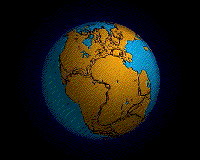| Name | Age (Ma) | Period/Era Range | Type | Comments | Sources |
|---|
| Amazonia | 1300 | | Craton | | [1] [2] [3] |
| Arabia–Nubia | 610 | Neoproterozoic | Microcontinent | Rifted off Rodinia at about 840 Ma. Then accreted to North Africa with large volume of juvenile crust during the Pan-African orogeny to form the Arabian-Nubian Shield. | [4] [5] |
| Arctica | 2565 | Neoarchean | Supercraton | | [6] |
| Argoland | 155 | | an archipelago of microcontinents | Rifted off Australia 155 Ma ago after splitting into microcontinents about 215Ma ago | [7] [8] |
| Atlantica | 1500 | Mesoproterozoic | Continent | Formed from a series of cratons during the development of Columbia - independent from about 1500 Ma, following break-up of Columbia - part of Rodinia from 1000 Ma | [2] |
| Avalonia | 800 | Cambrian | Continent | Rifted off northern Gondwana in the Cambrian, eventually colliding with Laurentia and Baltica in the Caledonian Orogeny to form Laurussia. | [9] |
| Baltica | 2000 | Paleoproterozoic | Continent | Formed from three cratonic fragments - the Baltic Shield, Sarmatia and Volgo–Uralia. Formed part of Columbia, then Rodinia and Pannotia. Collided with Laurentia and Avalonia to form Laurussia. | [1] [4] [2] [10] |
| Cathaysia | 1800 | | Continent | Fused with the Yangtze block to form the South China Craton during the Early Paleozoic. | [11] |
| Cimmeria | 300 | Late Carboniferous–Early Permian | Continent | Rifted off margin of Gondwana, opening up Neotethys, collided with Laurasia about 150 Ma in the Cimmerian Orogeny. Regarded as being made up of many separate continental fragments. | [12] |
| Columbia (Nuna) | 2100 | Paleoproterozoic | Supercontinent | Oldest widely accepted supercontinent. also known as Nuna. | [13] [3] |
| East Antarctica | | | Craton | | [14] |
| East European | | | Craton | The cratonic core of Baltica or a synonym for the paleocontinent | [2] [10] |
| Gondwana | 500 | Late Neoproterozoic | Continent | Also described as a supercontinent | [4] [15] |
| India | | | Continent | | [1] [4] |
| Kalahari | | | Craton | | [1] [4] |
| Kazakhstania | | | Continent | | [16] |
| Kenorland | 2720 | Neoarchean | Supercontinent | Alternatively, landmasses may have grouped into two supercratons, Sclavia and Superia | [17] |
| Laurasia | | Carboniferous-Permian | Continent | Formed by the break-up of Pangaea after Kazakhstania and Siberia had joined with the former Laurussia | [15] |
| Laurentia | 1830 | Paleoproterozoic | Continent | | [1] |
| Laurussia | 425 | Early Devonian | Continent | The "Old Red Continent" formed by the Caledonian Orogeny, joined with Gondwana to form Pangaea | [18] |
| Mawson | 1730 | Paleoproterozoic | Continent | | [3] |
| Nena | 1900 | Paleoproterozoic | Continent | | [13] |
| North Australia | 2000 | Paleoproterozoic | Craton | | [19] |
| North China | 2500 | Paleoproterozoic | Craton | | [1] [4] |
| Pangaea | 350 | Late Permian | Supercontinent | | [15] |
| Pannotia | 600 | Neoproterozoic | Supercontinent | | [20] |
| Rodinia | 1000 | Mesoproterozoic | Supercontinent | | [4] |
| São Francisco–Congo | 1800 | Proterozoic | Craton | | [1] [13] |
| Sahul | | Paleoproterozoic | Continent | mainland Australia, Tasmania, New Guinea, and Aru Islands. | [21] |
| Sclavia | | Paleoarchean | Supercraton | | [17] |
| Siberia | 2800 | Neoarchean | Continent | | [1] [4] |
| South Australia | | | Craton | | [19] |
| South China | | Neoproterozoic | Craton | | [4] |
| Superia | 2680 | Neoarchean | Supercraton | | [17] |
| Tarim | | Early Mesoproterozoic | Craton | | [22] [4] |
| Ur | 3100 | Mesoarchean | Continent | | [23] |
| Vaalbara | 3300 | Late Neoarchean–Early Paleoproterozoic | Continent | | [17] |
| West Africa | | Paleoproterozoic | Craton | | [2] [1] [3] |
| West Australia | 2000 | Paleoproterozoic | Craton | | [19] |
| Yangtze | 1800 | Late Neoarchean–Early Paleoproterozoic | Craton | Fused with the Cathaysia block to form the South China Craton during the Early Paleozoic. | [11] |
